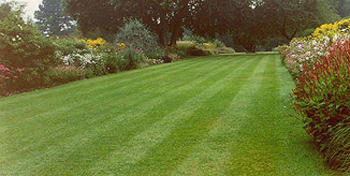June 11, 2007
Splendor In The Grass: Enjoying Your Lawn

By Michael D. Shaw
As we approach the middle of June, many of us are getting back to the art and science of maintaining our lawns.
Like so many quintessentially American things, we got the notion of having a beautiful lawn from the English. Unfortunately, grasses native to this continent did not lend themselves to that tidy English look, and English grass seeds did not fare well in many regions of our country. It took good old American ingenuity, in the form of collaboration between the Department of Agriculture and the US Golf Association—among others—to find the right grass or combination that would thrive stateside.
By 1930, after looking at Bermuda grass from Africa, blue grass from Europe, and a blend of Fescues and bent grass, several suitable mixtures were found, and attractive lawns would spring up everywhere.
These days, though, some critics contend that the pesticides and chemicals preserving and greening our lawns are harsh carcinogens which pose a serious threat to adults, children, and pets. Some voices go as far as calling for the banning of these substances, or failing that, demand that the property owner forgo planting grass or trees for a more “natural” look.
The trouble is, this look would likely resemble a stark desert landscape or simply concrete. Indeed, over-development of many arid regions has already given us a good idea of this grim visage.
One favorite target of the Greens is a popular weed killer called 2,4-dichlorophenoxyacetic acid (or 2,4-D) used by homeowners and farmers. A widely publicized 1991 study by the National Cancer Institute reported that the rate of canine lymphoma, a cancer that strikes the immune system, doubled among dogs whose owners used 2,4-D on lawns four or more times per year.
Scary stuff, huh? However, the methodology of the study was attacked by John Kaneene, director of the Population Medicine Center at the Michigan State University School of Veterinary Medicine, who stated:
“We were unable to support the conclusions reached by the (Cancer Institute) concerning the relationship between 2,4-D exposure and canine malignant lymphoma.”
Dr. Stephen Sternberg of Memorial Sloan-Kettering Cancer Center in New York said he was not surprised by Kaneene’s findings, adding:
“The (Cancer Institute) study was no good…There was no physical examination of any of the dogs. The researchers assumed the dogs were exposed to 2,4-D from licking the bottoms of their feet, which they don’t really do.”
And, in 2005, the US EPA—hardly a softie on carcinogens—reported that:
“The EPA’s assessment of the human and environmental scientific data reinforces a growing number of regulatory decisions and expert reviews that conclude the use of 2,4-D according to product instructions does not present an unacceptable risk to human health or the environment.”
Finally, Jack Fry, professor of horticulture at Kansas State University, reminds us that:
“Most of these products are tested and retested for safety. There shouldn’t be a problem if consumers follow the directions on the container. Most lawn chemical products are as safe or safer than many chemicals we use daily inside our homes.”
But, enough about the chemicals. It turns out that there are plenty of environmental benefits of lawns.
- They stabilize soil against water and wind erosion and increase water infiltration into the soil
- The turfgrass root zone is an area of high soil microorganism activity, and this actually promotes the breakdown of pesticides into harmless basic elements
- Combined with trees and shrubs, lawns can reduce the air temperatures around homes by 7 to 14 °F (3.3-6.6 °C)
- Lawns provide a safer play surface for children than asphalt or concrete
- Lawns contribute to improved air quality by acting as traps for dust and other particulate matter
- Lawns, through the process of photosynthesis, contribute to a reduction in atmospheric carbon dioxide, while giving back oxygen. A healthy lawn area of 25 square feet (2.3 sq. meters) will provide enough oxygen for one adult for one day.
And, let’s not forget. A beautiful lawn looks great, and increases the value of your home!
Take a moment to smell the roses…and mow the lawn.

